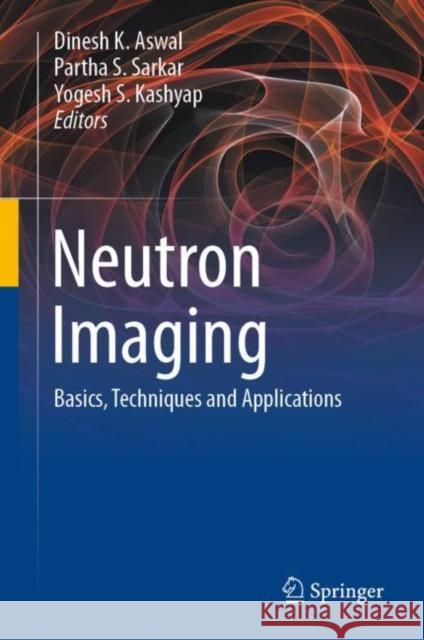Neutron Imaging: Basics, Techniques and Applications » książka



Neutron Imaging: Basics, Techniques and Applications
ISBN-13: 9789811662720 / Angielski / Twarda / 2022 / 378 str.
Neutron Imaging: Basics, Techniques and Applications
ISBN-13: 9789811662720 / Angielski / Twarda / 2022 / 378 str.
(netto: 535,46 VAT: 5%)
Najniższa cena z 30 dni: 539,74
ok. 22 dni roboczych
Dostawa w 2026 r.
Darmowa dostawa!
Introduction to Neutron Physics and Imaging.- Physics and Design of Neutron Sources.- Neutron Optics and Detectors.- Major Neutron Source Facilities Across the Globe.- Basic Principles of Neutron Radiography and Tomography.- Advanced Neutron Imaging Techniques.- Standards, Safety and Regulations in Neutron Imaging.- Neutron Imaging for Aerospace Industry.- Neuron Imaging for Nuclear, Power and Manufacturing Industry.- Neutron Imaging for Materials Science and Engineering Applications.- Neutron Imaging for Archelogy, Palaeontology and Geomechanics Applications.- Neutron Imaging for National Security, Biological and Medical Applications.
Dr. Dinesh K. Aswal is Director, Health Safety and Environment Group at Bhabha Atomic Research Centre (BARC), Department of Atomic Energy (DAE), Government of India, Mumbai. He has had several positions like Director, CSIR- National Physical Laboratory (CSIR-NPL), New Delhi; Director, Central Electronics Engineering Research Institute (CEERI, Pilani); Director, Science, Technology and Development Studies (CSIR-NISTADS, New Delhi); Chairman, National Accreditation Board for Testing and Calibration Laboratories (NABL); Secretary, and Atomic Energy Education Society (AEES), Mumbai etc. Dr. Aswal joined BARC through the training school batch of the year 1986 after completing M.Sc. in Physics (Gold medalist) from Garhwal University in 1985. He obtained his Ph.D. in Physics from Mumbai University and subsequently carried out post-doctoral research work at the Research Institute of Electronics, Hamamatsu, Japan. He is known for “Aswal model of inclusive growth” and made several outstanding contributions in the areas of metrology, molecular electronics, physics of organic films and their applications, thermoelectric power generators and gas sensors. He has had visiting professor/scientist positions at several international institutes/universities viz. Institut d 'Electronique de Microelectronique et de Nanotechnologie (France), Sizuoka University (Japan), Commissariat à l'Energie Atomique (France), Weizmann Institute of Science (Israel), University of Yamanashi (Japan), University of Paris VII (France), Karlsruhe institute of Technology (Germany), and the University of South Florida (USA). He is a recipient of several national and international awards/fellowships, including Fellow of National Academy of Sciences, India (NASI); Academician, Asia Pacific Academy of Materials; Fellow, International Academy of Advanced Materials (Sweden); Distinguished Faculty Award of Homi Bhabha National Institute (HBNI); Materials Research Society of India (MRSI) Meda; Homi Bhabha Science and Technology Award,;DAE-SRC Outstanding Research Investigator Award; etc. He has edited five books, published over 500 journal/conference papers.
Dr. Partha S Sarkar is a Scientific Officer in Technical Physics Division at Bhabha Atomic Research Centre (BARC), Mumbai. He had joined BARC in 2000 after his Masters in Physics from Indian Institute of Technology, Kharagpur, India. Subsequently he obtained his PhD (Physics) from the University of Mumbai for his contribution to the field of radiation imaging techniques. He has been involved in developing radiation imaging techniques using X-rays and neutrons for non-destructive testing and evaluation towards nuclear, manufacturing industry, medical and societal applications. He has also been involved in developing systems towards medical imaging and field applications. He is presently involved in developing techniques and systems towards illicit material detection and special nuclear material detection towards nuclear safeguards. He is recipient of Young Applied Scientist and Technologist award from Department of Atomic Energy in the year 2009. He has published around 65 research papers in refereed journals including a book chapter involving Tomography with X-rays and neutrons. He is also a faculty member of Homi Bhabha National Institute (HBNI), Mumbai, as Associate professor in the discipline of Physical sciences.
Dr. Yogesh S Kashyap joined Bhabha Atomic Research Centre (BARC), Department of Atomic Energy (DAE), Government of India, Mumbai as Scientific officer in 2001, after completing his Masters in Physics from Indian Institute of Technology, Kanpur, India. Subsequently, he obtained his PhD (Physics) from the University of Mumbai, in the field of phase contrast X-ray and Neutron imaging. He was involved in installation& commissioning of Neutron imaging beamlines at CIRUS and Dhruva research reactor, Trombay and development of various industrial application of compact neutron generators. He has also made significant contribution in the development of X-ray imaging beamline at Indus-2, synchrotron source, India . He has worked on the development of multi-modal phase retrieval methods as a research associate at Diamond Light source, UK and developed in-situ near-field speckle based metrology system for quantification of mirror slope errors. He is recipient of Young Applied Scientist and Technologist award from Department of Atomic Energy in the year 2011 for development of X-ray phase contrast and neutron imaging techniques. He is also a faculty member of Homi Bhabha National Institute (HBNI), Mumbai, as Associate professor in the discipline of Physical sciences. He has contributed two book chapters and published around 90 papers in journal/conference.
This book comprehensively presents the concepts of neutron physics and imaging including neutron properties, neutron matter interaction, neutron imaging, comparison with X-ray and physics and design of neutron sources. It discusses how neutron imaging has gained importance as a powerful non-destructive technique to understand the internal structures of materials/engineered components in wide range of industries, including defense, aerospace, and healthcare. The book also covers the topics of neutron optics and detectors, basic principles of neutron radiography and tomography, and standards, safety and regulations in neutron imaging. In the last section of the book, it covers wide range of applications of neuro imaging in the areas of aerospace industry, nuclear power and manufacturing industry, 3D printing, materials science and engineering, geomechanics, archeology and palaeontology, national security, biological, and medical industries. Given its scope, the book will be highly useful for postgraduate students, researchers and industry professionals working in the area of engineering and physics, especially non-destructive testing and non-destructive evaluation of neutron imaging.
1997-2025 DolnySlask.com Agencja Internetowa
KrainaKsiazek.PL - Księgarnia Internetowa









